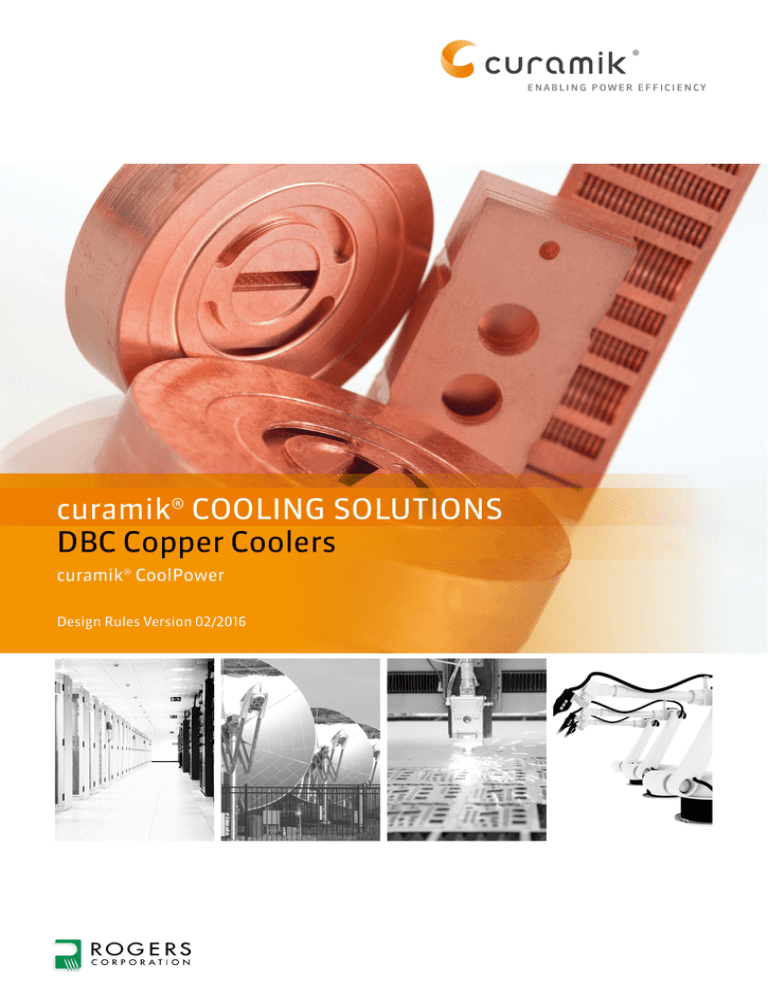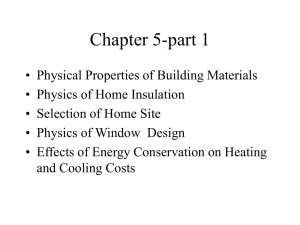
curamik® COOLING SOLUTIONS
DBC Copper Coolers
curamik® CoolPower
Design Rules Version 02/2016
Content
1. General construction of DBC copper coolers................... 03
5. Performance................................................................... 10
2. Cooling direction
6. Physical properties and recommendations
2.1. Serial cooling.................................................................... 03
6.1. Properties.......................................................................... 11
2.2. Parallel cooling................................................................ 03
6.1.1. Copper material.............................................................. 11
6.1.2. Temperature resistance................................................. 11
3. Cooler outline
6.1.3. Pressure resistance........................................................ 11
3.1. Geometric properties....................................................... 04
6.2. Recommendations........................................................... 11
3.1.1. Length, width and active cooled area........................... 04
6.2.1. Cooling fluid................................................................... 11
3.1.2. Wall thickness............................................................... 05
6.2.2. Flow velocity.................................................................. 11
3.1.3. Mounting holes............................................................. 05
6.2.3. Particle size................................................................... 11
3.1.4. Outside dimension tolerances...................................... 05
6.2.4. Cooling system.............................................................. 11
3.1.5. Thickness....................................................................... 06
3.1.6. Thickness tolerance...................................................... 06
3.2. Flatness........................................................................... 07
3.3. Inlet & Outlet................................................................... 07
3.3.1. O-Ring seats.................................................................. 07
3.3.2. Copper fittings (inner thread)...................................... 07
3.4. Holes................................................................................ 08
3.5. Assembly support............................................................ 09
4. Surface options
4.1. Surface roughness........................................................... 09
4.2. Plating...............................................................................10
1. General construction of DBC copper coolers
1
2
Top side
3
4
5
6
Picture 1 Example of cooler construction (see also table)
1
Fittings for in- and outlet (optional)
For connection of hoses / tubes
2
Bottom layer
Structured layer forming the inlet and outlet
3
Manifold layers (optional)
Structured layers to distribute the cooling liquid
4
Separation layer (optional)
Structured layer to guide the cooling liquid for more
uniform cooling of active side
5
Active cooling layers
Structured layers for liquid cooling
6
Top layer (active cooled side)
Plain copper layer for assembly of components
2. Cooling direction
2.1. Serial cooling
2.2. Parallel cooling
Cooling direction from the inlet to outlet side
Cooling direction crosswise to inlet and outlet
Outlet
flow
Inlet
Picture 2 Serial cooling
dire
ctio
n
Outlet
flo
w
Inlet
di
re
ct
io
n
Picture 3 Parallel cooling
curamik® COOLING SOLUTIONS I DBC Copper Coolers I Design Rules I Version 02/2016
03
3. Cooler outline
3.1. Geometric properties
3.1.1. Length, width and active cooled area
Max. outer
dimension [mm]
Max. active
cooled area [mm]
Pure Cu cooler without
mounting hole
158 x 107
155 x 104
Pure Cu cooler with
mounting hole
178 x 127
175 x 124
Note Heat spreading also at the edges of the cooler
Active cooled area
wall thickness
Picture 4 Length, width and active cooled area without mounting holes
mounting hole
Active cooled area
wall thickness
Picture 5 Length, width and active cooled area with mounting holes
04
curamik® COOLING SOLUTIONS I DBC Copper Coolers I Design Rules I Version 02/2016
3.1.2. Wall thickness
Minimum wall thickness (around active cooled area)
Depending on cooler size:
Outline ≤ 60 x 80 mm (w x l)
wall thickness ≥ 0.8 mm
Outline > 60 x 80 mm (w x l)
wall thickness ≥ 1.5 mm
wall thickness
Picture 6 Active cooled area and wall thickness (cross section)
3.1.3. Mounting holes
Typical diameter = 4.1 mm
Note Other diameters on request.
3.1.4. Outside dimension tolerances
Non machined cooler ≤ 0.3 mm copper
thickness of single layers (Picture 7)
± 0.2 mm
Non machined cooler > 0.3 mm copper
thickness of single layer (Picture 7)
± 0.25 mm
Machined cooler (Picture 8)
± 0.050 mm
Mismatch of single copper layers ≤ 0.15 mm
mismatch
Picture 7 Non machined cooler (mismatch)
curamik® COOLING SOLUTIONS I DBC Copper Coolers I Design Rules I Version 02/2016
05
thickness
Picture 8 Machined cooler (no mismatch)
3.1.5. Thickness
The thickness of the cooler depends on the number of active cooling layers.
Using a separation layer will increase the thickness of a cooler compared to a
cooler with no separation layer.
Typical number of active cooling layers
8 – 10
Minimum number of active cooling layers
2
Maximum number of copper layers
30
Available copper layer thicknesses in mm*
0.2 / 0.25 / 0.3 / 0.4 / 0.5 / 0.6
Maximum total thickness in mm
10
*Standard thickness of active cooling layers = 0.3 mm (other thickness on request)
Note More copper layers on request. Different thicknesses of copper layers
can be combined.
thickness
Picture 9 Cooler thickness
3.1.6. Thickness tolerance
Non machined cooler
Tolerance is depending on quantity and thickness of copper layers;
can be defined after first sample
evaluation
Top side diamond turned cooler
± 50 µm
Note For diamond turned coolers smaller tolerance on request.
06
curamik® COOLING SOLUTIONS I DBC Copper Coolers I Design Rules I Version 02/2016
3.2. Flatness
Requested flatness of coolers cannot be guaranteed in advance due to specific influences of the inner design
and circuit structure. Flatness (not 100% inspected) can only be specified after design definition and sample
delivery with initial sample test report.
3.3. Inlet & outlet
3.3.1. O-ring seat
bottom layer
sealing layer
Picture 10 O-Ring seat
Note O-Ring seat layer thickness = 0.6 mm recommended to avoid deformation of this layer.
Open cross section of inlet and outlet should be bigger than open cross section of cooling structure to avoid
high pressure drop in in- & outlet → open cross section of cooling structure approx. 50%.
3.3.2. Copper fittings (inner thread)
Picture 11 Fitting with G 1/8 inner thread
Note Fitting seat layer thickness = 0.6 mm recommended with fitting to avoid deformation of this layer.
Open cross section of inlet and outlet should be bigger than open cross section of cooling structure to avoid
high pressure drop in in- & outlet → open cross section of cooling structure approx. 50%.
curamik® COOLING SOLUTIONS I DBC Copper Coolers I Design Rules I Version 02/2016
07
x
y
Picture 12 Copper fittings tolerance
Note Tolerance of fittings X / Y ± 0.4 mm.
Other fitting dimensions and geometries on request.
3.4. Holes
Min. hole diameter ≥ 1 mm
Hole tolerance
≤ 0.3 mm copper layer thickness
± 0.2 mm
> 0.3 mm copper layer thickness
± 0.25 mm
Machined hole
on request (e.g. tight fit hole)
Ø hole
wall thickness
missmatch
Picture 13 Through hole
08
curamik® COOLING SOLUTIONS I DBC Copper Coolers I Design Rules I Version 02/2016
ll
th
n
ic k
le
s
ne
ho
s
V-V ( 4 : 1 )
B
Ø hole
C
C
wall thickness
Picture 14 Machined hole
D
D
3.5. Assembly support
M(5:1)
N(5:1)
M(5:1)
N(5:1)
( 10 : 1 )
R ( 10 : 1 )
E
Surface
THE REPRODUCTION, TRANSMISSION OR USE OF
THIS DOCUMENT OR ITS CONTENTS IS NOT
PERMITTED WITHOUT EXPRESS WRITTEN AUTHORITY.
OFFENDERS WILL BE LIABLE FOR DAMAGES. ALL
RIGHTS CREATED BY PATENT GRANT OR REGISTRATION
OF A UTILITY MODEL OR DESIGN, ARE RESERVED.
Units:
Surface
THE REPRODUCTION, TRANSMISSION OR USE OF
THIS DOCUMENT OR ITS CONTENTS IS NOT
Units:
mm/Metric
mm/Metric
E
SAP No.:
SAP No.:
Picture
Examples
of assembly
in for
theinternal
side of
the
cooler forDate
nuts or Name
plates / slot in cooler surface to enable screw position fixing
PERMITTED 15
WITHOUT
EXPRESS WRITTEN
AUTHORITY. support
File (slot
Revision
use
only
OFFENDERS WILL BE LIABLE FOR DAMAGES. ALL
RIGHTS CREATED BY PATENT GRANT OR REGISTRATION
OF A UTILITY MODEL OR DESIGN, ARE RESERVED.
Drawn
Note Other on request.
File Revision for internal use only
Date
04.09.2014
Curamik GmbH 010/2012
Norm: DIN ISO 2768-mK
04.09.2014 SchrenS
01 Curamik
first sample
GmbH 010/2012
Changes
Date
Name
Norm: DIN ISO 62768-mK
Standard
State
4. Surface options
State
Changes
Name
F
Ansichten/Schnitte
Drawing No.
DR_sketches
Ansichten/Schnitte
F
5
A2
G:\Construction\00_Vorlagen\00_97_DesignRules\Cooler\Skizzen-Design-Rules\Schnitt_Lagenaufbau\DR_sketches.idw
Drawing No.
7
5
DR_sketches
04.09.2014 SchrenS
Date
Design Rules Cooler
Design Rules Cooler
Standard
Name
SchrenS
Checked
01 first sample
SchrenS
Checked
Drawn
5
04.09.2014
8
A2
G:\Construction\00_Vorlagen\00_97_DesignRules\Cooler\Skizzen-Design-Rules\Schnitt_Lagenaufbau\DR_sketches.idw
6
4.1. Surface
roughness
7
8
a) Standard: Rmax = 50 µm; Ra ≤ 4 µm; Rz ≤ 16 µm
b) Diamond turned surface: Rmax ≤ 10 µm; Ra ≤ 0,8 µm; Rz ≤ 5 µm *
*Depending on surface plating lower values possible
curamik® COOLING SOLUTIONS I DBC Copper Coolers I Design Rules I Version 02/2016
09
4.2. Plating
Electroless Ni
3 – 7 µm (8% ± 2% P)
Electroless Ag
0.1 – 0.6 µm
Electroless NiAu
Ni: 3 – 7 µm (8% ± 2% P)
Au: 0.03 – 0.13 µm
Note Inside plating is not possible. No plating in tight fit holes.
5. Performance
Pressure drop and thermal resistance
(Example for 10 active cooling layers 0.3 mm thickness & standard cooling structure)
Pressure Drop & Rth(A)
500
0.4
450
0.35
400
0.3
0.25
300
250
0.2
200
0.15
150
0.1
100
0.05
50
0
0
0.00
1.00
Rth(A)
2.00
3.00
4.00
5.00
6.00
Flowrate [l/min]
Pressure Drop
10
curamik® COOLING SOLUTIONS I DBC Copper Coolers I Design Rules I Version 02/2016
7.00
Rth(A) [K*cm2/W]
Pressure Drop [mbar]
350
6. Physical properties and recommendations
6.1. Properties
6.1.1. Copper material
OFHC copper
6.1.2. Temperature resistance
Max. 400 °C
6.1.3. Pressure resistance
Max. 5 bar (no leakage, deformation possible depending on design)
6.2. Recommendations
6.2.1. Cooling fluid
Tap water (no DI-water!), no corrosive fluids
6.2.2. Flow velocity
< 2 m/s (critical value for flow corrosion; depending on water temperature this value can be lower)
6.2.3. Particle size
≤ 200 µm (depending on inner cooler design smaller)
6.2.4. cooling system
Do not use materials which build a galvanic cell with copper (e.g. Al, Zinc, brass), preferably V4A-alloy without sulfur.
Use synthetic materials (tubes, gaskets, etc.) with lower diffusivity of oxygen and without soluble additives.
The information contained in this document is intended to assist you in designing with Rogers’ Power Electronics Solutions
Materials. It is not intended to and does not create any warranties, express or implied, including any warranty of merchantability or fitness for a particular purpose or that the results shown in this document will be achieved by a user for a particular
purpose. The user should determine the suitability of curamik® products for each application. The Rogers logo, the curamik
logo and curamik are trademarks of Rogers Corporation.
© 2016 Rogers Corporation. All rights reserved.
This document is not subject of updating.
Version 02/2016 issued in February 2016.
Issued by Nico Kuhn and Paul Ren
Approved by Tomas Block and Stephan Schrenker
curamik® COOLING SOLUTIONS I DBC Copper Coolers I Design Rules I Version 02/2016
11
Rogers Germany GmbH
Am Stadtwald 2
92676 Eschenbach
Germany
Phone +49 9645 92 22 0
Fax +49 9645 92 22 22
www.rogerscorp.com/pes



